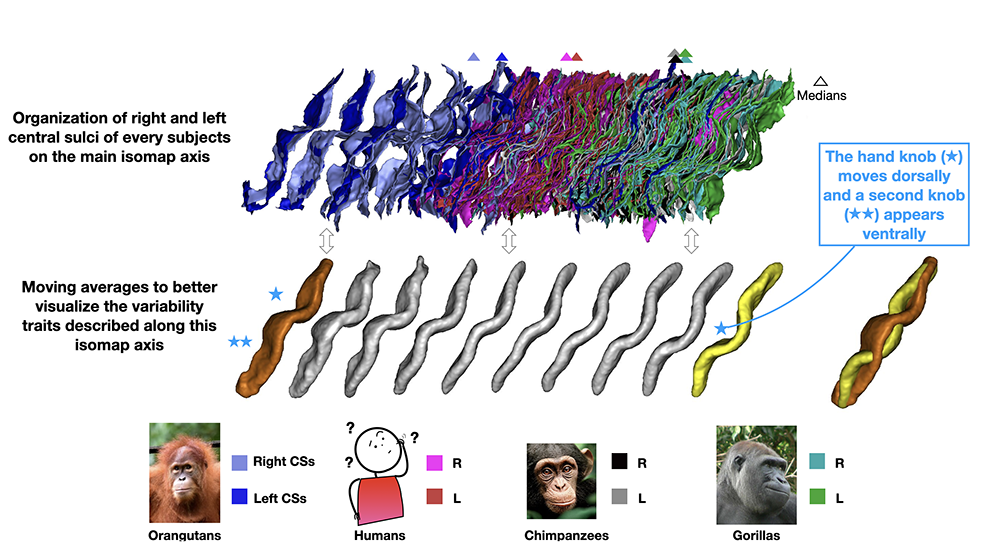
Comparative morphometry of the shape of the central sulcus using Isomap
We examined here the morphological variability of the central sulcus in hominids, with a focus on the motor hand region, significant issue of human evolution.
For 30 years, we have been improving our tools for automatic recognition of cortical sulci. The latest generation (L. Borne, B. Cagna, C. Fischer) relies on deep learning and distillation techniques to learn first a representation of the folding variability on a very large number of brains before exploiting a database of a few hundred brains whose sulci have been manually labeled. Sulcus morphometry is used in a multitude of collaborations to establish biomarkers, e.g., for pathologies of aging (WQ Shu-Quartier-Dit-Maire). But we are approaching the limits of the current anatomical nomenclature, which is not adapted to certain observed patterns.
This is why for a few years we question the usual idea that an atlas can be adapted to any brain. We seek to infer with unsupervised deep learning approaches a dictionary of all the folding patterns (L. Guillon, A. Gaudin, J. Chavas). The goal is to be able to decompose any brain from this dictionary and potentially to highlight anomalies when an observed pattern is not listed. We use generative models and contrastive models to bias the dictionary towards folding patterns predictive of behavioral traits or developmental pathologies.
We are also developing machine learning analyses to project the geometric variability of a sulcus or a pattern into a low-dimensional manifold, in order to quantify possible links with a pathology or a behavior (Z. Y. Sun, M. Pascucci). We have adapted these strategies to the analysis of the development of the folding of premature babies (H. de Vareille) and to the comparison of the folding of great apes with that of humans (O. Foubet).
In the context of the Human Brain Project, we have established the first atlases of short-range connectivity through U-fibers (M. Guevara, N. Labra, N. Vindas) and new parcellations of the cortical surface integrating connectivity from diffusion MRI and cytoarchitectonicity (C. Langlet, XY Wang). Our ultimate goal is to link folding variability with connectivity and architectonics variability.
• Denis Rivière - Research Scientist
• Joël Chavas - Research Engineer
• Clément Langlet - PhD 2026 (prepared under co-superv. J.-F Mangin, D. Rivière)
• Nabil Vindas - PhD 2024 (under superv. J.-F. Mangin, V. Frouin)
• Julien Laval - PhD 2027 (prepared under co-superv. J.-F. Mangin, D. Rivière, J. Chavas, P. Gori)
• Matthieu Perrot - PhD 2009 (prepared under co-superv. J.-F. Mangin, D. Rivière)
• Joy Sun - Postdoc (under superv. J.-F. Mangin)
• Pauline Roca - PhD 2011 (prepared under co-superv. J.-F. Mangin, D. Rivière)
• Pamela Guevara - PhD 2011 (prepared under co-superv. J.-F. Mangin, C. Poupon, Y. Cointepas)
• Sandrine Lefranc - PhD 2015 (prepared under co-superv. J.-F. Mangin, D. Rivière)
• Yann Leprince - PhD 2015 (prepared under co-superv. J.-F. Mangin, D. Rivière, C. Poupon)
• Jessica Lebenberg - Postdoc 2017 (under superv. J.-F. Mangin, D. Rivière)
• Olga Domanova (under co-superv. D. Rivière, J.-F. Mangin) - Postdoc 2015-2017
• Léonie Borne - PhD 2020 (prepared under co-superv. J.-F. Mangin, D. Rivière)
• Miguel Guevara - PhD 2020 (prepared under superv. J.-F. Mangin)
• Nicole Labra - PhD 2020 (prepared under superv. J.-F. Mangin)
• Héloïse de Vareilles - PhD 2022 (prepared under co-superv. J.-F. Mangin, D. Rivière, J. Dubois)
• Joël Chavas - CDD 2020-2024 (under superv. J.-F. Mangin, D. Rivière)
• Louise Guillon - PhD 2023 (prepared under co-superv. J.-F. Mangin, D. Rivière)
• Ophélie Foubet - Postdoc 2020-2024 (under superv. J.-F. Mangin)